In this article, we will discuss how to grow the beautiful flowering shrub of Berberis in containers. Berberis is a large genus of around 700 species in their own family of Berberidaceae (the Barberry). Berberis are deciduous or evergreen shrubs that grow between 1 to 5m tall. They tend to be easy to grow and will thrive in most soil conditions throughout the world. They grow in temperate regions and will grow in subtropical regions, where the only country not to report a native species, is Australia.
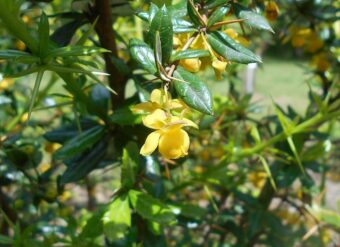
The genus is noted for its wide diversity amongst the genus, where it is more noticeable in species on different continents. The best-known species is the common Berberis vulgaris which is found throughout the world.
The biggest problem is that you will find even in a modest small garden centre a bewildering choice of species and varieties. There are slow-growing species and there are dwarfs, which are more suited to be grown in containers. What is common with many species of Berberis is that they have spikes along the stems and the margins of the leaves.
Berberis tend to produce long shoots that form the structure of the plant and short shoots only grow up to 2mm long. The leaves on the long shoots tend not to photosynthesize, developing into one or more spikes that are 3 to 30mm long. At the exit of each thorn, the short shoots that develop have several leaves that photosynthesize. The leaves are often small (1 to 10cm long), simple and either entire or have spiny margins.
THE DECIDUOUS SPECIES ARE ATTRACTIVE
Many deciduous species such as Berberis thunbergii and Berberis vulgaris, are noted for their attractive colourful red and yellow leaves. Chinese species are valued for the evergreen leaves (Berberis candidula and Berberis verruculosa) are noted for the leaves that are brilliantly white underneath. Some varieties of Berberis thunbergii are noted for their red or violet foliage.
They are not only grown for the attractive leaves but the masses of flowers that steal the show. The flowers are either produced singly or in racemes on a single flower head. The flowers are usually yellow or orange and consist of six sepals and six petals in alternating whorls of three. The sepals and petals are typically the same colour.
The flowers are followed by small fruits and true berries that are often red or dark blue, often with a pink or violet waxy surface. The fruits are often spherical but they can be cylindrical.
Find out how to grow Berbers in containers in this article.
GROWING BERBERIS IN CONTAINERS
Berberis will do well in any reasonable quality soil, so will do well in most containers. You will need to make sure the Berberis you buy is a container-grown specimen, otherwise, it will not do well.
First, choose a container that has some drainage holes at the bottom and is well-balanced with the shrub in question.
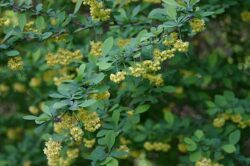
For larger plants choose larger containers, whilst for dwarf species, you can use a 30cm+ diameter pot. Whatever you choose make sure it has plenty of drainage holes at the bottom. To aid drainage further add a 2cm layer of gravel at the bottom of the container. On top of this add up to 5cm of the top rim with a reasonable quality multipurpose compost.
Dig a hole at the centre of the container slightly bigger than the root ball it came in the original pot (normally 2 to 3 litres).
Place the plant in so that the top of the root ball is at the same level as the top surface of the compost in the container. Backfill with the growing media so that no gaps remain, using more compost if necessary. Firm it well and then water thoroughly.
The best time to plant is either April or October.
THE BEST GROWING CONDITIONS
Place your container in a spot it will get either full sun or partial shade, never deep shade. In deep shade, it will never flower well.
You will need to water newly planted Berberis regularly until it well-established. Watering frequently is especially important in hot, dry summer, Water when the surface feels dry to the touch. After that water when 5cm below the top surface of the compost feels dry to the touch. Water until it emerges from the drainage holes. Do not overwater as Berberis hate being overwatered. Remember to remove pot saucers from under containers in winter to prevent from this happening.
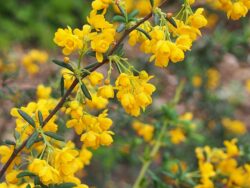
In containers, Berberis will need to be fed with a slow-release, general-purpose fertilizer in spring to give a boost throughout the growing season. This is very important.
HOW TO PRUNE BERBERIS
Pruning is not necessary but it is encouraged to keep the shrub compact in size and shape and to get a better foliage effect. How to prune depends if the shrub is deciduous or evergreen. As Barberry is very spiny, make sure you wear protective clothing like gloves and eye protection.
For deciduous Berberis, it is best to prune in mid to late winter, whilst dormant. Species like Berberis thunbergii will require removing wayward shoots to preserve their shape. You will need to thin the oldest stems to ground level every few years to encourage new growth. Cultivars with bright or variegated leaves can be cut back harder. If you want the autumn leaf colours then you will need to keep pruning to a minimum. Other deciduous species will not need pruning.
Evergreen Berberis should be pruned after flowering in early to mid-summer or in autumn or winter to avoid losing the berry display. If you need to do is prune out any wayward shoots, which must be done annually to keep it in size and shape.
Berberis responds well to hard pruning where it can be cut to 30cm above the ground level in later winter. After this give a feed with a liquid, general-purpose fertilizer and mulch to encourage new growth. You will lose flowers and berries for one season.
Alternatively, you can prune a third of the side branches to encourage new replacement shoots to form.
PROPAGATING SUCCESSFULLY IS BASED ON LUCK
Propagating Berberis is based on luck as often cuttings will not take. The recommended method is semi-ripe cuttings taken in Mid-summer and early autumn. You can use these cuttings, which is the most successful methodology for most Berberis species. Take a 10cm long current season growth and carefully pull these so that they come easily away from the plant, with a sliver of bark as a heel from the parent plant.
For species that produce thick stems, you can choose a thick stem that grew in the present season. Cut this stem into 15cm long specimens, where the top and below cuts are taken just above and below a leaf joint. Cut off the soft growing tip.
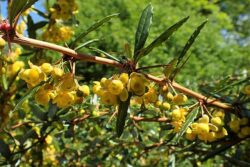
For thin stemmed species that are difficult to root and have long side shoots can be propagated by taking cuttings from this season’s growth of side shoots or last’s year’s stems. Cut just above and below where the side-shoots joint to create a cutting with small pieces of old wood at the base. Again remove the soft top and lower leaves.
Place each cutting in rooting hormone powder and then place them in a heated propagator. This will need to be placed into a cold frame and planted out the following spring.
You can grow from seeds but as they are so many hybrids it will never breed true. It is well worth the effort if you like surprises but for others, it is not worth the effort.
For species that produce long, arching stems then you can use simple layering where flexible, low-growing stems are pressed down with a metal clip to a container full of seed-sowing compost. More success is guaranteed if this is carried out in spring for evergreens and autumn or spring for deciduous species.
PESTS AND DISEASES
In general, Berberises are pests and diseases free. However Berberis thunbergii can suffer from burnt tips from late spring frosts and in droughts during hot, dry summers, variegated and golden-leaved varieties are prone to scorching from too much direct sunlight. These scorched leaves can be easily pruned out. Too much drought can result in powdery mildew which can be prevented by watering and providing good air circulation around the leaves.
Aphids can be a problem but this is nothing compared to the Berberis sawfly, which ferociously feeds on Berberis leaves. They can totally defoliate a tree. Established plants usually recover, but it is best to prevent it from happening in the first place by spraying with a systemic insecticide using a regular regime.
In wet conditions look out for root rot and the death of the plant.
BERBERIS VARIETIES TO GROW
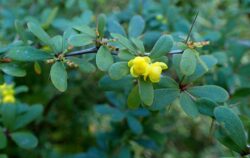
The following species and varieties are recommended to be grown in containers.
Berberis x stenophylla has narrow leaves, arching stems and golden flowers in April and May. Evergreen varieties include ‘Irwinii’ which grows up to 1m tall and ‘Corallina Compacta’ which grows up to 30cm high.
A plant that produces linear green leaves and orange flowers is Berberis trigona ‘Orange King’ which grows up to 2m high.
Berberis verruculosa has small glossy, green leaves and produces solitary yellow flowers and black fruits. It grows up to 1.33m tall.
For a Berberis that produces dense masses of yellow flowers in May, Berberis candidula is for you.
For deciduous Berberis, you have the basic Berberis thunbergii that has bright red autumn leaves and berries. They are several interesting varieties that can be grown ‘Atropurpurea- Dart’s Red Lady’ which grows up to 60m tall and has purple leaves and mostly thornless stems, ‘Nana’ only grows up to 60cm tall and has dark bronze leaves that turn red in autumn, ‘Aurea’ has yellow leaves that turn green in late summer and grow up to 1.5m tall. Other varieties include ‘Rosy Rocket’ with pink-mottled purple leaves, ‘Harlequin’ with white-speckled, deep-pink leaves and ‘Red Chief’ with deep red leaves and ‘Bagatelle’ which grows up to 30cm high and deep red leaves.
Berberis wilsoniae has large orange berries in autumn.
A final species is Berberis x ottawensis ‘purpurea’ which grows up to 1.2m tall and has arching stems of rich purple stems.
CONCLUSIONS
In this article, we have discussed how to grow a large family of flowering shrubs of Berberis in containers. As you can see you have such a large choice of what species and variety to grow. They, in general, are easy to care for, requiring little in the way of pruning, Although they are not totally pests and diseases free, any problems should be easy to handle.
If you have any questions or comments that you wish to make on growing Berberis in containers, please do so in the comment box below.
Happy Berberis growing.
